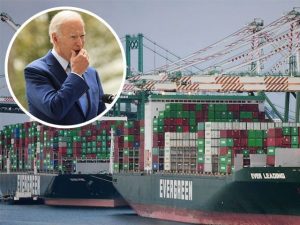
Those of us who live in the supply chain every day know it is a complicated business. As the name “supply chain” suggests, it is a series of actions and handoffs, each intrinsically linked and dependent upon the other.
With a total of 102 ships (down from 115 last week) in the San Pedro Bay, we fully appreciate it is broken. It has been broken for some time, but like the scrappy, adaptable group we are, we have collectively held it together with duct tape, baling wire and sheer will.
Until….the whole world was locked down and duct tape, baling wire and will were no longer enough to keep goods moving.
With people unable to spend money on services, movies or restaurants, they turned their attention to hard goods and the sofa they could no longer stomach after living with it 24/7, the new work-from-home attire that became a necessity, or the kitchen that was in desperate need of a re-do. Since they could no longer walk into a store and pick out the sofa, work-from-home pants or new appliances, they turned to on-line shopping.
Ecommerce boomed. Demand for container shipping soared. The workforce on the front lines contracted and recovered from COVID. Landside operations found it difficult to keep up with the tidal wave of freight. The system melted down and logistics chaos ensued.
Twenty months into the pandemic, and everyone has heard about the supply chain and its struggles. Scary reports of an empty-shelf Christmas were broadcasted far and wide.
Then…the government stepped in to “fix” the problem. We appreciate they were addressing a problem the public was clamoring and demanding be resolved. After all, Christmas was at stake. But, they are woefully uneducated about the intricacies and complications of the supply chain.
That being said, fresh eyes are not entirely a bad thing. There are some good ideas being brought forth…getting the FMC involved to provide relief from detention and demurrage charges, increasing the number off-dock container depots, allowing drivers as young as 18 to become a commercial truck driver, increasing terminal operating hours, pushing for a grey chassis pool are just a few examples. But, it takes time and buy-in from all stakeholders to make these ideas a reality.
There are no easy fixes or quick resolutions to the backlog, congestion and hurdles faced in the logistics network. One cannot simply flip a switch or assess a $100/day fee and solve the problem. If it was that easy, the scrappy, adaptable group we are would have done it long ago.